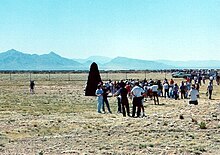
Back السياحة الذرية Arabic سياحه نوويه ARZ Atom turizmi Azerbaijani Tourisme atomique French അറ്റോമിക് ടൂറിസം Malayalam Атомный туризм Russian Атомний туризм Ukrainian Du lịch nguyên tử Vietnamese

Atomic tourism or nuclear tourism is a form of tourism in which visitors witness nuclear tests or learn about the Atomic Age by traveling to significant sites in atomic history such as nuclear test reactors, museums with nuclear weapon artifacts, delivery vehicles, sites where atomic weapons were detonated, and nuclear power plants.[1][2]
In the United States, the Center for Land Use Interpretation has conducted tours of the Nevada Test Site, Trinity Site, Hanford Site, and other historical atomic age sites, to explore the cultural significance of these Cold War nuclear zones. The book Overlook: Exploring the Internal Fringes of America describes the purpose of this tourism as "windows into the American psyche, landmarks that manifest the rich ambiguities of the nation's cultural history."[3][4][5] A Bureau of Atomic Tourism was proposed by American photographer Richard Misrach and writer Myriam Weisang Misrach in 1990.[6][7]
Visitors to the Chernobyl Exclusion Zone often visit the nearby deserted city of Pripyat.[1] The Hiroshima Peace Memorial (Genbaku Dome), which survived the destruction of Hiroshima, is now a UNESCO World Heritage Site at the center of Hiroshima Peace Memorial Park.[8] Bikini Atoll was at one time the site of a diving tourism initiative.[9] As of 2012, China planned to build a tourist destination at its first atomic test site, the Malan Base at Lop Nur in the Xinjiang Uyghur Autonomous Region.[10]
Several nuclear power plants offer tours of the facilities or provide education at visitor centers.
- ^ a b Boyle, Rebecca (2017). "Greetings from Isotopia". Distillations. 3 (3): 26–35. Retrieved June 14, 2018.
- ^ Italie, Leanne (March 30, 2011). "Japan disaster boosts interest in atomic tourism". AZ Central/Associated Press. Retrieved 15 June 2018.
- ^ Sayer, Kyeann. "Overlook: Exploring the Internal Fringes of America with the Center for Land Use Interpretation". treehugger.com. Treehugger. Retrieved 19 October 2014.
- ^ Center for Land Use Interpretation. "Open House at the Nevada Test Site: And a Glimpse of what a Nuclear Test Site Tourist Attraction Might be Like". CLUI.ORG. Center for Land Use Interpretation. Retrieved 19 October 2014.
- ^ Coolidge, edited by Matthew; Simons, Sarah; Rugoff (forward), Ralph (2006). Overlook : exploring the internal fringes of America with the Center for Land Use Interpretation. New York: Metrolpolis Books. ISBN 978-1933045337.
{{cite book}}:|first1=has generic name (help) - ^ Misrach, Richard; Weisang Misrach, Myriam (1990). Bravo 20: The Bombing of the American West. Baltimore: Johns Hopkins University Press. ISBN 978-0801840647.
- ^ Beck, John (2009). Dirty wars landscape, power, and waste in western American literature. Lincoln: University of Nebraska Press. p. 332. ISBN 9780803226692.
- ^ UNESCO. "Hiroshima Peace Memorial (Genbaku Dome)".
- ^ Gwynne, S. C. (October 17, 2012). "Paradise With an Asterisk". Outside. Retrieved 15 June 2018.
- ^ "Former Chinese nuclear bomb base turned into tourist attraction". CNN Travel. 17 October 2012. Retrieved 15 June 2018.
© MMXXIII Rich X Search. We shall prevail. All rights reserved. Rich X Search